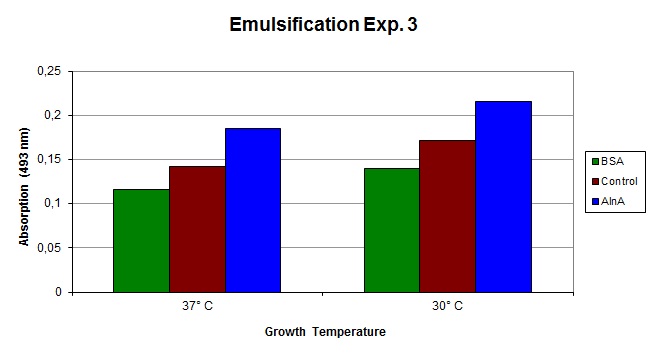Part:BBa_K398206
AlnA generator (IPTG inducible)
AlnA is a protein with emulsification activity originated from the natural oil degrading bacterium Acinetobacter radioresistens. The expression of AlnA in E.coli, induced by IPTG, has shown to increase the solubility of the hydrophobic dye Sudan II by 20% in cell extract assays. This BioBrick could therefore be used to increase the amount of dissolved hydrophobic compounds.
Introduction
AlnA is a protein with emulsification activity originated from the natural oil degrading bacterium Acinetobacter radioresistens. It has been shown that this protein keeps its emulsifying capacities when it is produced by other organisms, such as Escherichia coli.
AlnA has an amphipathic structure, which allows it to form micelles that accumulate at the interface between liquids of different polarities such as water and oil. This process is based upon the ability of biosurfactants to reduce surface tension, blocking the formation of hydrogen bridges and certain hydrophilic and hydrophobic interactions. The emulsifier helps to disperse the oil by emulsifying the oil, thus increasing the surface area for the growth of microorganisms on hydrocarbons.
The original sequence is available in GenBank http://www.ncbi.nlm.nih.gov/nuccore/17978529. We optimized it for expression in E. coli and removed unwanted restriction sites.
Characterization
For determining the emulsification capacity of a substance we developed our own emulsifier assay. The main difference to the existing assays is that instead of emulsifying a colorless hydrocarbon, we added the orange Sudan II dye. This molecule stains non-polar molecules and hardly dissolves in water. The addition of the dye makes measuring the emulsification much easier, because of it’s nice absorbance peak at 493 nm.
Read the [http://2010.igem.org/Team:TU_Delft#page=Notebook/protocols&anchor=Emulsifier_assay Emulsification Assay protocol].
Results
The expression of AlnA, induced by IPTG, has shown to increase the solubility of the hydrophobic dye Sudan II by 20% in cell extract assays. The full [http://2010.igem.org/Team:TU_Delft#page=Project/solubility characterization of the BBa_K398206] is described on the TU Delft iGEM Team 2010 wiki.
References
- Walzer, G., Rosenberg, E. and Ron, E.Z. The Acinetobacter outer membrane protein A (OmpA) is a secreted emulsifier. Environmental Microbiology. 8:1026-1032.(2006)
- Toren, A., Segal, G., Ron, E.Z. and Rosenberg, E. Structure--function studies of the recombinant protein bioemulsifier AlnA. Environmental Microbiology. 4:257-261.(2002)
- Navon-Venezia, S., et al. Alasan, a new bioemulsifier from Acinetobacter radioresistens. Applied and Environmental Microbiology. 61:3240-3244.(1995)
- Toren, A., Orr, E., Paitan, Y., Ron, E.Z. and Rosenberg, E. The active component of the bioemulsifier alasan from Acinetobacter radioresistens KA53 is an OmpA-like protein. The Journal of Bacteriology. 184:165-170.(2002)
- Toren, A., Navon-Venezia, S., Ron, E.Z. and Rosenberg, E. Emulsifying activities of purified Alasan proteins from Acinetobacter radioresistens KA53. Applied and Environmental Microbiology. 67:1102-1106.
- Ron, E.Z. and Rosenberg, E. (2002) Biosurfactants and oil bioremediation. Current Opinion in Biotechnology. 13:249-252.(2001)
- Suresh Kumar, A., Mody, K. and Jha, B. Evaluation of biosurfactant/bioemulsifier production by a marine bacterium. Bulletin of Environmental Contamination and Toxicology. 79:617-621.(2007)
Sequence and Features
- 10COMPATIBLE WITH RFC[10]
- 12COMPATIBLE WITH RFC[12]
- 21COMPATIBLE WITH RFC[21]
- 23COMPATIBLE WITH RFC[23]
- 25COMPATIBLE WITH RFC[25]
- 1000COMPATIBLE WITH RFC[1000]
| None |



